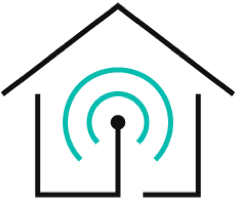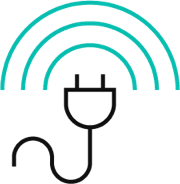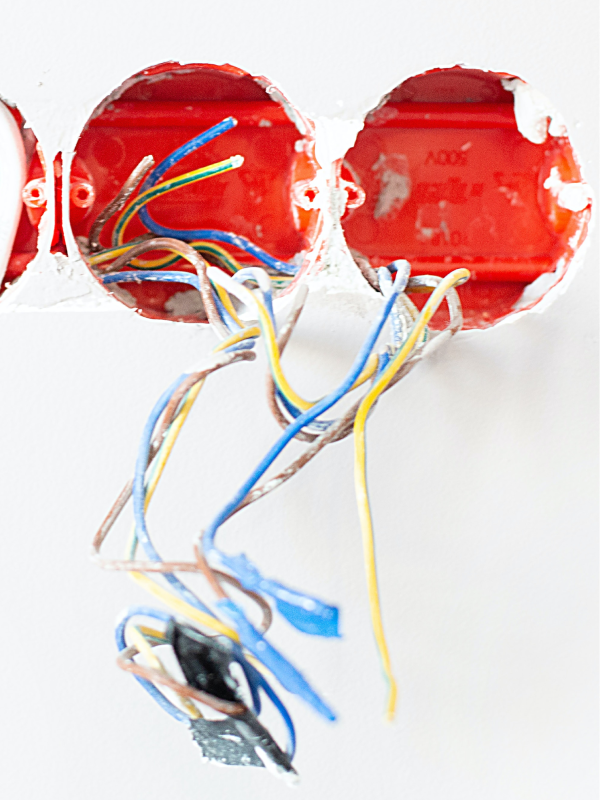Electric circuits are complex systems composed of various wires, each performing a specific function. Therefore, to thoroughly comprehend the functioning of an electric circuit, it is imperative to delve into the roles and significance of these wires. Two common wire types are hot and neutral wires that allow electricity to flow from the power source, through the connected device, and back to the source. Understanding their interplay is fundamental for maintaining the stability and safety of an electrical circuit.
To help you learn more about hot and neutral wires, we are going to discuss their applications, working, and importance in detail. Let's dig in!
- Understanding Electrical Wires
- Differences between Hot and Neutral Wires: How to Distinguish
- Importance of Neutral Wires in Traditional Switches
- Introduction to EVVR In-Wall Relay Switch
- Benefits of No Neutral Wire Smart Switches
Understanding Electrical Wires
An electric wire is a conductive medium, typically composed of copper or aluminum, that facilitates the transmission of electrical current within an electrical circuit. They are pathways for the flow of electricity, connecting various components, devices, or systems. Hot and neutral wires are the critical wires, but the three main types are:
- Hot Wire (Live Wire): The hot wire carries the current from the power source to the electrical device. It is usually color-coded black or red and is the conductor through which electrical energy is supplied to the connected equipment.
- Neutral Wire: Serving as the return path for electric current, the neutral wire completes the electrical circuit. It is typically color-coded white or gray and is grounded to prevent potential electrical hazards. The neutral wire ensures a balanced flow of electricity and safety in the circuit.
- Ground Wire: This wire provides a path for electrical currents to safely dissipate into the ground in the event of a fault, preventing the buildup of excess voltage. It is a crucial safety feature, typically color-coded green or bare.
Difference Between Wire and Cables
Most people confuse wires and cables as the same thing, but they aren't. A wide is a single, solid, or stranded conductor made of metal (such as copper or aluminum) that conducts electrical current. Contrarily, a cable combines two or more insulated wires bundled together. These wires may be twisted, braided, or laid together within a protective sheath.
Now that you know about hot and neutral wires, you must learn about some common cable types:
- Coaxial Cable: Coaxial cables consist of a central conductor, usually copper, surrounded by a layer of an insulating material, a metallic shield, and an outer sheath or jacket. They are useful for transmitting cable television signals, internet connectivity (broadband connections), and other data communication applications.
- Twisted Pair Cables: Twisted pair cables consist of insulated copper wires twisted together. They can be shielded or unshielded and have a bandwidth specification. Twisted pair cables are suitable for networking applications, such as Ethernet cables for local area networks (LANs), telephone lines, and other data transmission systems.
- Fibre Optics Cable: Fiber optic cables consist of hundreds of optical fibers in plastic casings that transfer data as light pulses. You'll find them ideal for high-speed data transmission over long distances - telecommunications, internet connectivity, and audio/video signal transmission.
Differences between Hot and Neutral Wires: How to Distinguish
Hot and neutral wires don't look alike. You can easily identify them using various devices or tools. Here are some methods to differentiate hot and neutral wires:

Using Multimeter
Here's how you can identify hot and neutral wires with a multimeter:
- Ensure the multimeter is in good working condition. Wear proper protective equipment, such as insulated gloves and safety goggles.
- Turn the multimeter dial to the voltage setting. Select an appropriate voltage range; a range of 120-240 volts is usually sufficient for household circuits.
- Insert the black probe into the common (COM) port on the multimeter.
- Insert the red probe into the voltage (V) port, turn on the multimeter, and set it to measure AC voltage.
- Hold the black probe against a ground or neutral reference point (like the ground wire or a neutral terminal).
- Touch the tip of the red probe to the exposed part of a wire suspected to be hot.
- The multimeter should display the voltage if the wire is hot.
- Move the red probe along the wire to check for voltage at different points.
- If the multimeter reads a voltage higher than a few volts, it indicates the wire is likely hot and carrying an electrical current.
- Turn off the multimeter after use.
Using Testing Screwdriver
In case you don't have a multimeter, you can use a testing screwdriver to find out the hot wire in an electrical circuit.
Let's discuss how you can easily identify hot and neutral wires using a testing screwdriver:
- Press the "power" button on the tester screwdriver to turn it on.
- Confirm that both the power light and LED light are illuminated.
- With the tester screwdriver activated, touch the screwdriver's tip to the wire you want to test.
- If the wire is hot, the tester screwdriver will produce a beeping sound, and the LED light will illuminate.
- No reaction indicates that the wire is not carrying current, making it safe for work.
- After testing the wires, turn off the tester screwdriver by pressing the "power" button again.
- Store the screwdriver in a secure location until its subsequent use.
Importance of Neutral Wires in Traditional Switches
Now that you can distinguish between hot and neutral wires, let's look at the importance of neutral wires in traditional switches:
- Having a dedicated neutral wire helps maintain a stable voltage throughout the electrical system. It ensures that the electrical potential difference is consistent, allowing devices to operate reliably.
- In a standard switch configuration, the switch interrupts the hot wire, and the neutral wire remains connected. This design minimizes the risk of electric shock when operating the switch since the switch interrupts the live (hot) wire.
- Many electrical devices and appliances require both a hot and neutral connection to function correctly. The neutral wire provides the necessary return path for the current, allowing appliances to operate as intended.

Introduction to EVVR In-Wall Relay Switch
Smart switches usually have neutral wires to ensure the safety of connected appliances. However, some switches, like the EVVR In-Wall Relay Switch, require no neutral wire and offer excellent protection.
Now that you know everything about hot and neutral wires, let's discuss the best no-neutral wire smart switch.
EVVR In-Wall Relay Switch
The EVVR In-Wall Relay Switch is a revolutionary smart lighting solution that ensures your home stays connected and always online. What sets this smart relay switch apart is its continuous connectivity, even when the wall switch is turned off.
Unlike conventional smart bulbs or switches, the Smart Relay remains accessible via apps or voice commands through popular voice assistants like Google Assistant, Alexa, and HomeKit Siri. This provides you with seamless control of your lighting system. One standout feature is the absence of a neutral wire requirement during installation, offering flexibility and saving time and money.
Say goodbye to the hassle of rewiring electrical systems within walls and ceilings and embrace the convenience of smart lighting without a hefty investment. Size is no limitation with the EVVR In-Wall Relay Switch. Divided into two parts, the Smart Switch component is exceptionally compact, almost the size of a coin. This allows for versatile placement, which can fit two Smart switches into any electrical box, supporting up to a 4-gang switch panel.
Key Features
Here are the critical features of EVVR In-Wall Relay Switch
Always Connected, Always Online:
- Smart Relay remains connected even when the wall switch is turned off.
- Control the lighting system wirelessly via apps or voice commands (Google Assistant, Alexa, HomeKit Siri).
Compatibility with All Wall Switches:
- Works seamlessly with both modern and classic wall switches.
- Preserve the aesthetic integrity of your home's decor during the smart lighting upgrade.
Make Any Bulbs Smart:
- Compatible with various regular bulbs: incandescent, halogen, fluorescent, and LED.
- Transform your entire lighting setup into a smart system without replacing bulbs.
Hardwired 3-Way or 4-Way Control:
- Supports control with existing wall switches.
- No neutral wire is required for hardwired 3-way or 4-way configurations, ensuring easy installation.

Benefits of No Neutral Wire Smart Switches
Understood everything about hot and neutral wires? Let's discuss the benefits of having no neutral wire intelligent switches in your home!
- Simplified Installation: No need for a neutral wire streamlines the installation process, making it more accessible for users without extensive electrical expertise.
- Compatibility with Older Homes: Ideal for retrofitting older homes where the absence of a neutral wire is common, allowing homeowners to enjoy smart technology without major renovations.
- Versatility: Opens up possibilities for installation in locations where a neutral wire may not be readily available, providing flexibility in positioning smart switches throughout the home.
- Cost Savings: Eliminates the need for rewiring, reducing installation costs and making smart home device installation more affordable.
Conclusion
Understanding the difference between hot and neutral wires is essential to ensure you properly comprehend the functioning of an electric circuit. You can also follow the abovementioned steps to identify hot and cold wires in a circuit. In case you are searching for a switch that doesn't come with a neutral wire,
EVVR In-Wall Relay Switch is the solution. Our switch doesn't require a neutral wire for installation and is perfect for homeowners who want to bring technology into old homes. We also offer products like the EVVR Energy Monitoring Smart Plug and Relay, EVVR Pad S, EVVR Center Lite, and more. Get in touch and have an amazing home automation experience!















